Performance Evaluation of Polypropylene Fiber-Reinforced Pavement Quality Concrete Made with Waste Granite Powder
Abstract
:1. Introduction
| R. No. | Author (Year) | Type of Waste | Nature of Replacement in Concrete | Type of Concrete | Finding |
|---|---|---|---|---|---|
| [28] | Prokopski et al. (2020) | Granite dust | Partial replacement of sand. “Portland cement—granite dust—sand” system | Medium-strength concrete | WGP increased the average density of concrete and provided dense micro-structure, the water absorption was reduced by 32–38%, and the water penetration was decreased by 60–70%, when granite dust was added to the concrete mix. The strength was increased about 17 to 19% when compared with the control concrete. |
| [29] | Jain et al. (2020) | Granite powder | Partial replacement of fine aggregate | Self-compacting concrete | The strength and durability properties were improved at up to 40% and 60% substitution levels of granite powder, respectively. |
| [30] | Ahmed and Tobbala (2022) | Granite dust | Partial replacement of fine aggregate up to 60% | Engineered cementitious composites (ECC) | Greater mechanical properties were achieved, while the water absorption was reduced by 28.8% at 10% replacement level of granite dust. |
| [31] | Shwetha et al. (2022) | Granite waste | Partial replacement of cement | Normal-strength concrete | The mechanical properties were enhanced with w/c ratio of 0.45. |
| [32] | Mohsen et al. (2022) | Granite waste | Partial replacement of cement | Normal-grade concrete for structural applications | Up to 45 °C, the substitution of 25% granite waste as the cement replacement caused a significant increase in the viscosity, yield stress, and strength properties. |
| [33] | Lu et al. (2023) | Granite powder | Partial replacement of sand | Cement mortar | The substitution of granite powder as an inert material could promote the hydration of cement and decreased the porosity and water absorption. |
| [34] | Kim et al. (2023) | Granite waste | Partial replacement of cement and fine aggregate | Cement mortar for masonry construction purpose | The workability was increased when a particle size of smaller than 0.15 mm was used as the cement replacement and mitigated the drying shrinkage. The coarse particles of larger than the fraction size of 0.15 mm as the replacement of fine aggregate could contribute to the strength development. |
| [35] | Muñoz Pérez et al. (2023) | Granite powder | Partial replacement of sand | Normal-strength concrete | Reduction of the slump was observed. The strength properties were increased thanks to the substitution of granite powder up to 20%. |
2. Materials and Methods
2.1. Materials
2.1.1. Cement and Aggregates
2.1.2. WGP Preparation
2.2. Mix Proportioning
2.3. Methods
2.3.1. SAI
2.3.2. Fresh and Hardened Properties
2.3.3. Saturated Water Absorption
- Ms = Mass of saturated cube specimen
- Md = Mass of dry cube specimen
2.3.4. Sorptivity
- q = Quantity of water raised per unit contact area
- t = Exposure time
2.3.5. Acid Resistance
- fw = Compressive strength of PQC cured in water
- fa = Compressive strength of PQC immersed in acid
2.3.6. Chloride Penetration Depth
3. Results and Discussion
3.1. SAI
3.2. Effect of WGP on Workability of Fresh PQC
3.3. Effect of WGP on Mechanical Properties of Hardened PQC
3.3.1. Compressive Strength
3.3.2. Flexural Strength (Modulus of Rupture)
3.4. Effect of WGP on Durability Performance of PQC
3.4.1. Water Absorption
3.4.2. Sorptivity
3.4.3. Concrete Deterioration Due to Acid Attack by Visual Assessment
3.4.4. Concrete Deterioration Level Due to Acid Attack by SRF
3.4.5. Chloride Penetration Depth
3.5. Effect of PP Fibers in PQC
3.5.1. Slump Value of PPFRPQC Specimens
3.5.2. Compressive Strength of PPFRPQC Specimens
3.5.3. Flexural Strength of PPFRPQC Specimens
3.5.4. Correlation between Compressive Strength and Flexural Strength
3.5.5. SEM Image Evaluation of PQC Specimens
4. Conclusions
- The pozzolanic performance of WGP was evaluated by SAI and found that the SAI values of the 20% WGP-blended cement mortar were 0.77 and 0.87 after the curing periods of 7 days and 28 days, respectively. These results satisfied the ASTM C311 [40] provisions and hence, WGP can be considered as a suitable natural pozzolanic material in concrete.
- The slump value was decreased insignificantly from 39 mm to 38 mm (the slump value up to 15% WGP in the PQC mixtures), but a higher rate decrease of the slump value was found at higher rate beyond the presence of 15% WGP. The higher replacement of cement by WGP made the consistency of concrete became sticky, which caused the reduction of the slump value.
- The strength of the 15% WGP-blended specimen was 9.8% higher than the control PQC after 28 days of curing and 11.1% higher at a 20% WGP replacement level after 90 days of curing. The higher flexural strength of PQC was detected between at 15% and 20% of replacements of OPC by WGP with reference to the 28 days and 90 days curing periods.
- The encouraging combined effect between WGP and OPC up to a 20% replacement level in PQC was observed according to the SEM image evaluation.
- A decreased trend of sorptivity value was witnessed up to a 20% WGP replacement level after 28 days and 90 days of curing.
- The results of durability performance were tested by the water absorption, acid attack, and chloride penetration depth investigations after 28 days of curing, and better results were noticed than in the control concrete.
- The PPFRPQC specimens were developed and tested. An increasing trend in the compressive strength up to 0.5% addition of PP fibers and in the flexural strength up to 0.75% addition of PP fibers in the PPFRPQC specimens was accomplished. The correlation between the flexural strength and compressive strength was developed in the PPFRPQC specimens as fr = 0.7503(fc)0.5648 with a strong correlation coefficient of 0.9359.
- It is recommended that WGP can be used in PQC as a partial replacement of OPC of up to 18% without affecting the mechanical and durability properties and 0.5% PP fibers can be incorporated in the WGP-blended PQC specimens to develop PPFRPQCs.
Author Contributions
Funding
Data Availability Statement
Conflicts of Interest
References
- Kathirvel, P.; Sarswathy, V.; Karthik, S.P. Strength and durability properties of quaternary cement concrete made with fly ash, rice husk ash and limestone powder. Arbian J. Sci. Eng. 2013, 38, 589–598. [Google Scholar] [CrossRef]
- Dave, N.; Misra, A.N.; Srivastava, A.; Kaushik, S.K. Experimental analysis of strength and durability properties of quaternary cement binder and mortar. Constr. Build. Mater. 2016, 107, 117–124. [Google Scholar] [CrossRef]
- Memon, S.A.; Javed, U.; Shah, M.I.; Hanif, A. Use of processed sugarcane bagasse ash in concrete as partial replacement of cement: Mechanical and durability properties. Buildings 2022, 12, 1769. [Google Scholar] [CrossRef]
- Zeybek, Ö.; Özkılıç, Y.O.; Karalar, M.; Çelik, A.I.; Qaidi, S.; Ahmad, J.; Burduhos-Nergis, D.D.; Burduhos-Nergis, D.P. Influence of replacing cement with waste glass on mechanical properties of concrete. Materials 2022, 15, 7513. [Google Scholar] [CrossRef] [PubMed]
- Basaran, B.; Kalkan, I.; Aksoylu, C.; Özkılıç, Y.O.; Sabri, M.M.S. Effects of waste powder, fine and coarse marble aggregates on concrete compressive strength. Sustainability 2022, 14, 14388. [Google Scholar] [CrossRef]
- Moreira, J.M.S.; Freire, M.N.; Holanda, J.N.F. Utilization of granite powder waste in ceramic bodies for civil construction. In Materials Science Forum; Trans Tech: Stafa-Zurich, Switzerland, 2005; pp. 517–522. [Google Scholar]
- Guo, H.; Wang, Z.; Zhao, X.; Liu, J.; Ji, X.; Shi, W. Effects of dolomite powder on properties of environment-friendly cement asphalt emulsion composites. J. Clean. Prod. 2022, 369, 2022. [Google Scholar] [CrossRef]
- Islam, G.M.S.; Rahman, M.H.; Kazi, N. Waste glass powder as partial replacement of cement for sustainable concrete practice. Int. J. Sustain. Built Environ. 2017, 6, 37–44. [Google Scholar] [CrossRef]
- Elaqra, H.; Rustom, R. Effect of using glass powder as cement replacement on rheological and mechanical properties of cement paste. Constr. Build. Mater. 2018, 19, 326–335. [Google Scholar] [CrossRef]
- Taha, B.; Nounu, G. Using lithium nitrate and pozzolanic glass powder in concrete as ASR suppressors. Cem. Concr. Compos. 2008, 30, 497–505. [Google Scholar] [CrossRef]
- Kannan, D.M.; Aboubakr, S.H.; EL-Dieb, A.S.; Taha, M.M.R. High performance concrete incorporating ceramic waste powder as large partial replacement of Portland cement. Constr. Build. Mater. 2017, 144, 35–41. [Google Scholar] [CrossRef]
- Chen, X.; Zhang, D.; Cheng, S.; Xu, X.; Zhao, C.; Wang, X.; Wu, Q.; Bai, X. Sustainable reuse of ceramic waste powder as a supplementary cementitious material in recycled aggregate concrete: Mechanical properties, durability and microstructure assessment. J. Build. Eng. 2022, 52, 104418. [Google Scholar] [CrossRef]
- Gusain, P.; Sharma, S.; Debarma, S.; Sharma, A.K.; Mishra, N.; Dahale, P.P. Study of concrete mix by adding dolomite in conventional concrete as partial replacement with cement. Mater. Today Proc. 2023, 73, 163–166. [Google Scholar] [CrossRef]
- Kanmalai, W.C.; Partheeban, P.; Felixkala, T. Mechanical properties of high-performance concrete incorporating granite powder as fine aggregate. Int. J. Des. Manuf. Technol. 2008, 2, 67–73. [Google Scholar]
- Shamsabadi, E.A.; Ghalehnovi, M.; Brito, J.D.; Khodabakhshian, A. Performance of concrete with waste glass powder: The effect of superplasticizers. J. Appl. Sci. 2018, 8, 2018. [Google Scholar] [CrossRef]
- Allam, M.E.; Bakhoum, E.S.; Garas, G.L.; Ezz, H. Durability of green concrete containing granite waste powder. Int. J. Eng. Technol. 2016, 8, 2383–2391. [Google Scholar]
- Felix Kala, T. Properties of granite powder concrete. In Proceedings of the 1st International Conference on Infrastructure Development, Jawa Tengah, Indonesia, 1–3 November 2013; UMS Surakarta: Jawa Tengah, Indonesia, 2013. [Google Scholar]
- Vijayalakshmi, M.; Sekar, A.S.S.; Sivabharathy, M.; Ganesh Prabhu, G. Utilization of granite powder waste in concrete production. Defect Diffus. Forum 2012, 330, 49–61. [Google Scholar] [CrossRef]
- Arivumangai, A.; Felixkala, T. Strength and durability properties of granite powder concrete. J. Civ. Eng. Res. 2014, 4, 1–6. [Google Scholar]
- Ghannam, S.; Najm, H.; Vosconez, R. Experimental study of concrete made with granite and iron powders as partial replacement of sand. Sustain. Mater. Technol. 2016, 9, 1–9. [Google Scholar] [CrossRef]
- Vijayalakshmi, M.; Sekar, A.S.S.; Ganesh Prabhu, G. Strength and durability properties of concrete made with granite industry waste. Constr. Build. Mater. 2013, 46, 1–7. [Google Scholar] [CrossRef]
- Murthi, P.; Poongodi, K.; Saravanan, R.; Gobinath, R. Setting time of granite powder blended banana fibre reinforced high performance concrete. Int. J. Innov. Technol. Explor. Eng. 2020, 9, 891–896. [Google Scholar] [CrossRef]
- Thomas, F.K.; Partheeban, P. Study on the effect of granite powder on concrete properties. ICE 2009, 163, 63–70. [Google Scholar] [CrossRef]
- Binici, H.; Shah, T.; Aksogan, O.; Kaplan, H. Durability of concrete made with granite and marble as recycle aggregates. J. Mater. Process. Technol. 2008, 208, 299–308. [Google Scholar] [CrossRef]
- Naveenkumar, K.; Rohith, M.; Sagar, S.R.; Bandre, H.S. Properties of pavement quality concrete for partial replacement of natural coarse aggregates with coconut shell aggregates. Int. J. Appl. Eng. Res. 2018, 13, 146–149. [Google Scholar]
- Poongodi, K.; Murthi, P.; Gobinath, R.; Srinivas, A.; Sangeetha, G. Mechanical properties of pavement quality concrete using recycled aggregate. Int. J. Innov. Technol. Explor. Eng. 2020, 9, 33–38. [Google Scholar] [CrossRef]
- Murthi, P.; Poongodi, K.; Gobinath, R. Correlation between rebound hammer number and mechanical properties of steel fibre reinforced pavement quality concrete. Mater. Today Proc. 2021, 39, 142–147. [Google Scholar] [CrossRef]
- Prokopski, G.; Marchuk, V.; Huts, A. The effect of using granite dust as a component of concrete mixture. Case Stud. Constr. Mater. 2020, 13, e00349. [Google Scholar] [CrossRef]
- Jain, A.; Choudhary, R.; Gupta, R.; Chaudhary, S. Abrasion resistance and sorptivity characteristics of SCC containing granite waste. Mater. Today Proc. 2020, 27, 524–528. [Google Scholar] [CrossRef]
- Ahmed, T.I.; Tobbala, D.E. The role of granite dust in engineered cement composites as a partial replacement of fine aggregate. Innov. Infrastruct. Solu. 2022, 7, 104. [Google Scholar] [CrossRef]
- Shwetha, K.G.; Mahesh Kumar, C.L.; Dalawai, V.N.; Anadinni, S.B.; Sowjanya, G.V. Comparative study on strengthening of concrete using granite waste. Mater. Today Proc. 2022, 62, 5317–5322. [Google Scholar] [CrossRef]
- Mohsen, A.; Ramadan, M.; Gharieb, M.; Yahya, A.; Soltan, A.M.; Hazem, M.M. Rheological behaviour, mechanical performance, and anti-fungal activity of OPC-granite waste composite modified with zinc oxide dust. J. Clean. Prod. 2022, 341, 130877. [Google Scholar] [CrossRef]
- Lu, L.; Yang, Z.; Lin, Y.; Dong, S. Partial replacement of manufactured sand with homologous granite powder in mortar: The effect on porosity and capillary water absorption. Con. Build. Mat. 2023, 376, 131031. [Google Scholar] [CrossRef]
- Kim, J.; Lee, D.; Sicakova, A.; Kim, N. Utilization of different forms of demolished clay brick and granite wastes for better performance of cement composites. Buildings 2023, 13, 165. [Google Scholar] [CrossRef]
- Muñoz Pérez, S.P.; Atoche Zamora, J.J. Effects of incorporating granite powder in the mechanical properties of concrete. Sci. Rev. Eng. Env. Sci. 2023, 32, 18–23. [Google Scholar] [CrossRef]
- IS: 269-2015; Indian Standard for Ordinary Portland Cement–Specification (Sixth Revision). Bureau of Indian Standards: New Delhi, India, 2015.
- IRC: 44-2017; Guidelines for Cement Concrete Mix Design for Pavements (3rd Revision). Indian Roads Congress: New Delhi, India, 2017.
- Li, L.G.; Wang, Y.M.; Tan, Y.P.; Kwan, A.K.H. Filler technology of adding granite dust to reduce cement content and increase strength of mortar. Powder Technol. 2019, 342, 388–396. [Google Scholar] [CrossRef]
- IRC: 15-2011; Standard Specification and Code of Practice for Construction of Concrete Roads (Fourth Revision). Indian Road Congress: New Delhi, India, 2011.
- ASTM C311; Standard Test Methods for Sampling and Testing Fly Ash or Natural Pozzolanic for Use in Portland-Cement Concrete. American Society for Testing and Materials: West Conshohocken, PA, USA, 2013.
- ASTM C618; Standard Specification for Coal Fly Ash and Raw or Calcined Natural Pozzolan for Use in Concrete. American Society for Testing and Materials: West Conshohocken, PA, USA, 2023.
- IS: 1199-1959; Indian Standard for Method of Sampling and Analysis of Concrete (Eleventh edition). Bureau of Indian Standards: New Delhi, India, 2004.
- IS: 516–1959; Indian Standard for Method of Tests for Strength of Concrete (Eighteenth edition). Bureau of Indian Standards: New Delhi, India, 2006.
- ASTM C642-06; Standard Test Method for Density, Absorption, and Voids in Hardened Concrete. American Society for Testing and Materials: West Conshohocken, PA, USA, 2022.
- Choudhary, R.; Gupta, R.; Nagar, R.; Jain, A. Sorptivity characteristics of high strength self-consolidating concrete produced by marble waste powder, fly ash, and micro silica. Mater. Today Proc. 2020, 32, 531–535. [Google Scholar] [CrossRef]
- Murthi, P.; Sivakumar, V. Studies on acid resistance of ternary blended concrete. Asian J. Civ. Eng. 2008, 9, 473–486. [Google Scholar]
- Damrongwiriyanupap, N.; Sae-Long, W.; Limkatanyu, S.; Xi, Y. Influence of associated cautions on chloride ingress into concrete structures. Eng. J. 2021, 25, 51–60. [Google Scholar] [CrossRef]
- ASTM C1218/1218M-15; Standard Test Method for Water-Soluble Chloride in Mortar and Concrete. American Society for Testing and Materials (ASTM): West Conshohocken, PA, USA, 2004.
- Karim, M.R.; Hashim, H.; Razak, H.A. Assessment of pozzolanic activity of palm oil clinker powder. Constr. Build. Mater. 2016, 127, 335–343. [Google Scholar] [CrossRef]
- Singh, M. Coal Bottom Ash. In Waste and Supplementary Cementitious Materials in Concrete; Woodhead Publishing: Sawston, UK, 2018. [Google Scholar] [CrossRef]
- Janjaturaphan, S.; Wansom, S. Pozzolanic activity of industrial sugar cane bagasse ash. Suranaree J. Sci. Technol. 2010, 17, 349–357. [Google Scholar]
- Singh, B. Rice Husk Ash. In Waste and Supplementary Cementitious Materials in Concrete; Woodhead Publishing: Sawston, UK, 2018. [Google Scholar] [CrossRef]
- Mboya, H.A.; King’ondu, C.K.; Njau, K.N.; Mrema, A.L. Measurement of pozzolanic activity index of scoria, pumice and rice husk ash as potential supplementary cementitious materials for Portland cement. Adv. Civ. Eng. 2017, 2017, 6952645. [Google Scholar] [CrossRef]
- Chen, J.J.; Kwan AK, H.; Jiang, Y. Adding limestone fines as cement paste replacement to reduce water permeability and sorptivity of concrete. Constr. Build. Mater. 2014, 56, 87–93. [Google Scholar] [CrossRef]
- Gulsan, M.E.; Mohammedameen, A.; Sahmaran, M.; Nis, A.; Alzeebaree, R.; Cevik, A. Effects of sulphuric acid on mechanical and durability properties of ECC confined by FRP fabrics. Adv. Concr. Constr. 2018, 6, 199–220. [Google Scholar] [CrossRef]
- Kumar, N.V.S. Effect of sulphuric and hydrochloric acid solutions on crushed rock dust concrete. Mater. Today Proc. 2021, 46, 2021. [Google Scholar] [CrossRef]
- Min, H.; Song, Z. Investigation on the sulphuric acid corrosion mechanism for concrete in soaking environment. Adv. Mater. Sci. Eng. 2018, 2018, 3258123. [Google Scholar] [CrossRef]
- Poongodi, K.; Mahesh, V.; Murthi, P.; Sivaraja, M. Material performance of agro based hybrid natural fibre reinforced high strength concrete. In IOP Conference Series Materials Science and Engineering; IOP: Bristol, UK, 2020. [Google Scholar] [CrossRef]
- Murthi, P.; Poongodi, K.; Gobinath, R.; Saravanan, R. Evaluation of material performance of coir fibre reinforced quaternary blended concrete. In IOP Conference series Materials Science and Engineering; IOP: Bristol, UK, 2020. [Google Scholar] [CrossRef]
- IS: 456-2000 (R-2005); Indian Standard for Plain and Reinforced Concrete–Code of Practice (4th revision). Bureau of Indian Standards: New Delhi, India, 2005.
- Hu, C. Microstructure and mechanical properties of fly ash blended cement pastes. Constr. Build. Mater. 2014, 73, 618–625. [Google Scholar] [CrossRef]
- Lee, J.; Lee, T. Durability and engineering performance evaluation of CaO content and ratio of binary blended concrete containing ground granulated blast-furnace slag. J. Appl. Sci. 2020, 10, 2054. [Google Scholar] [CrossRef]

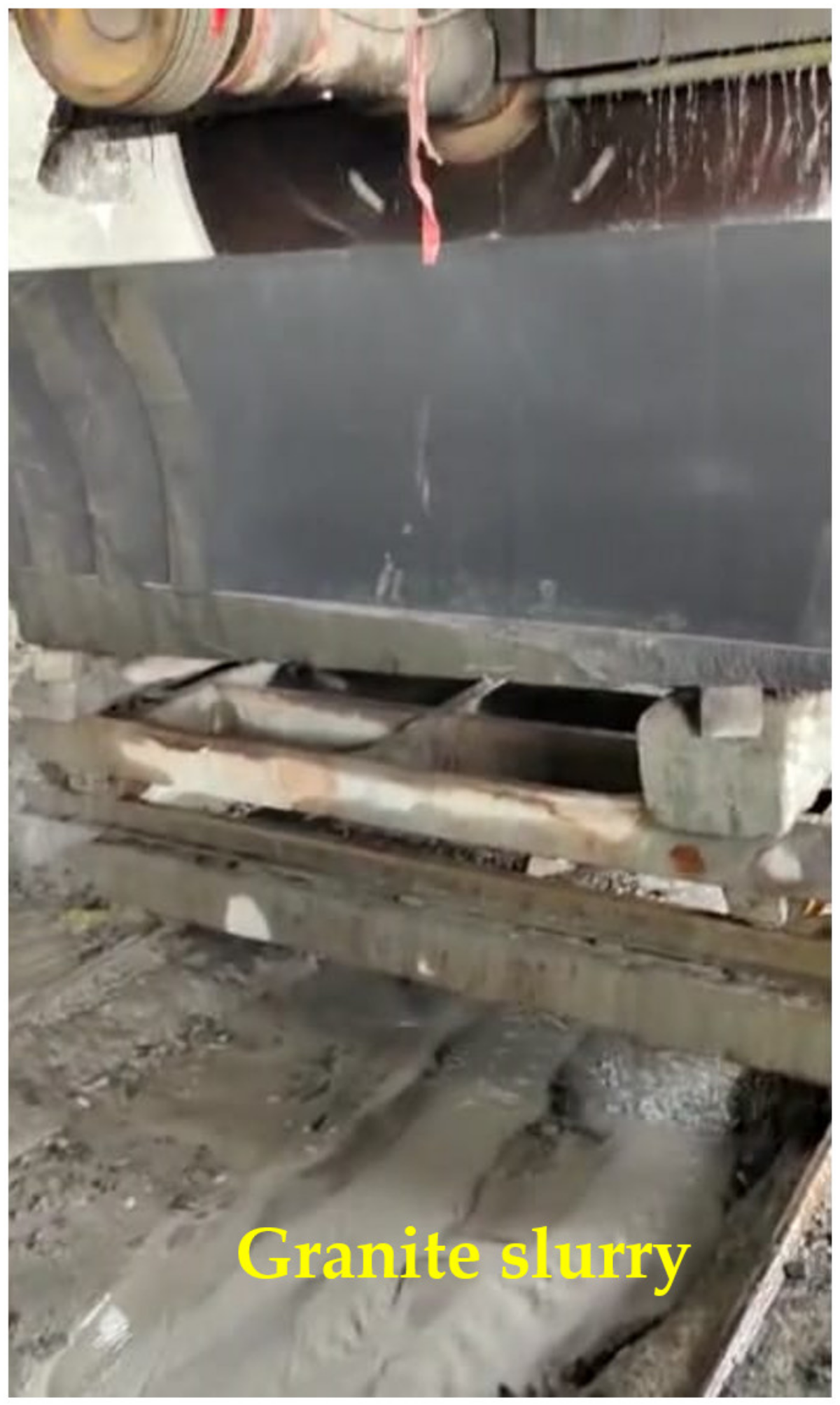



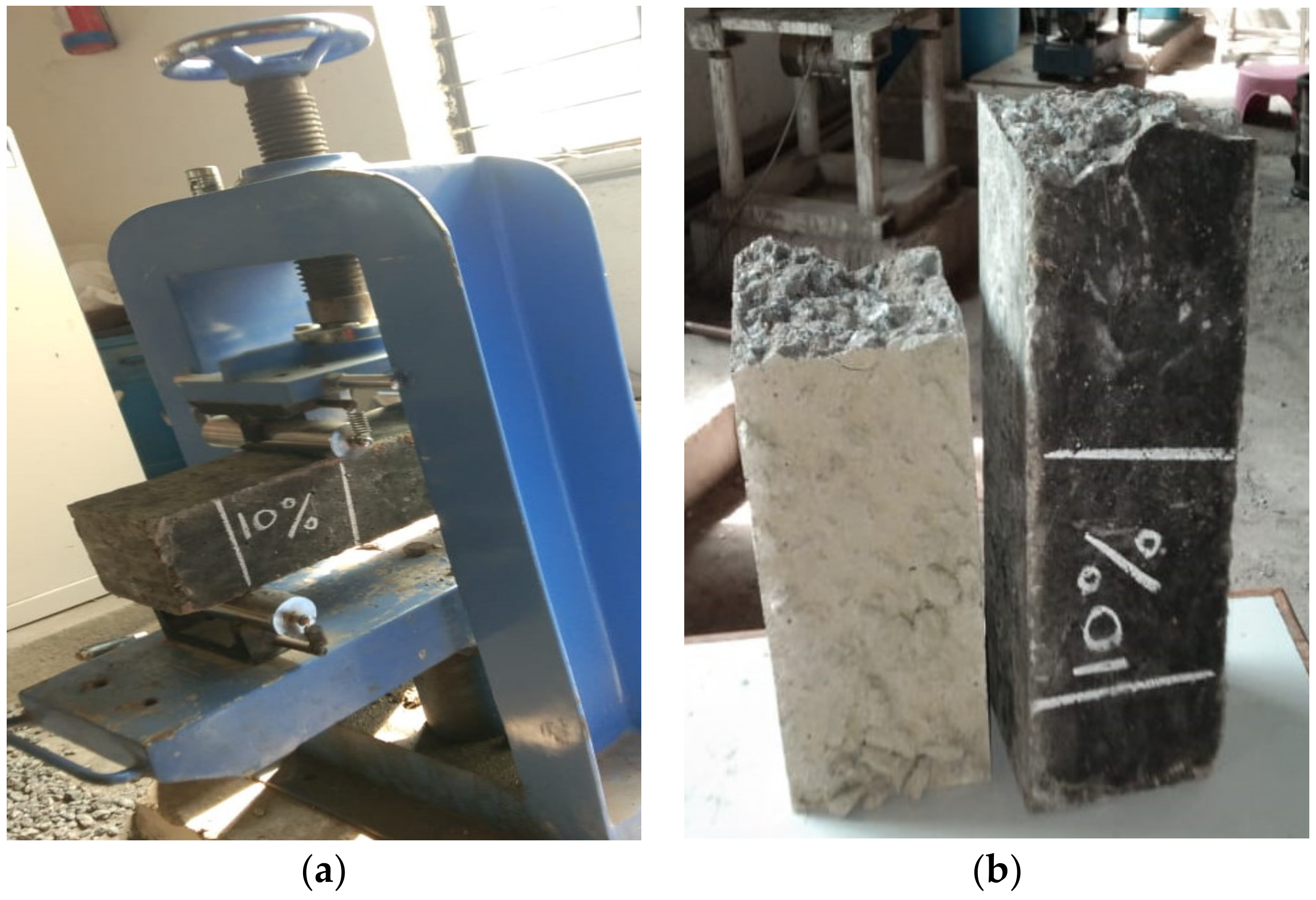
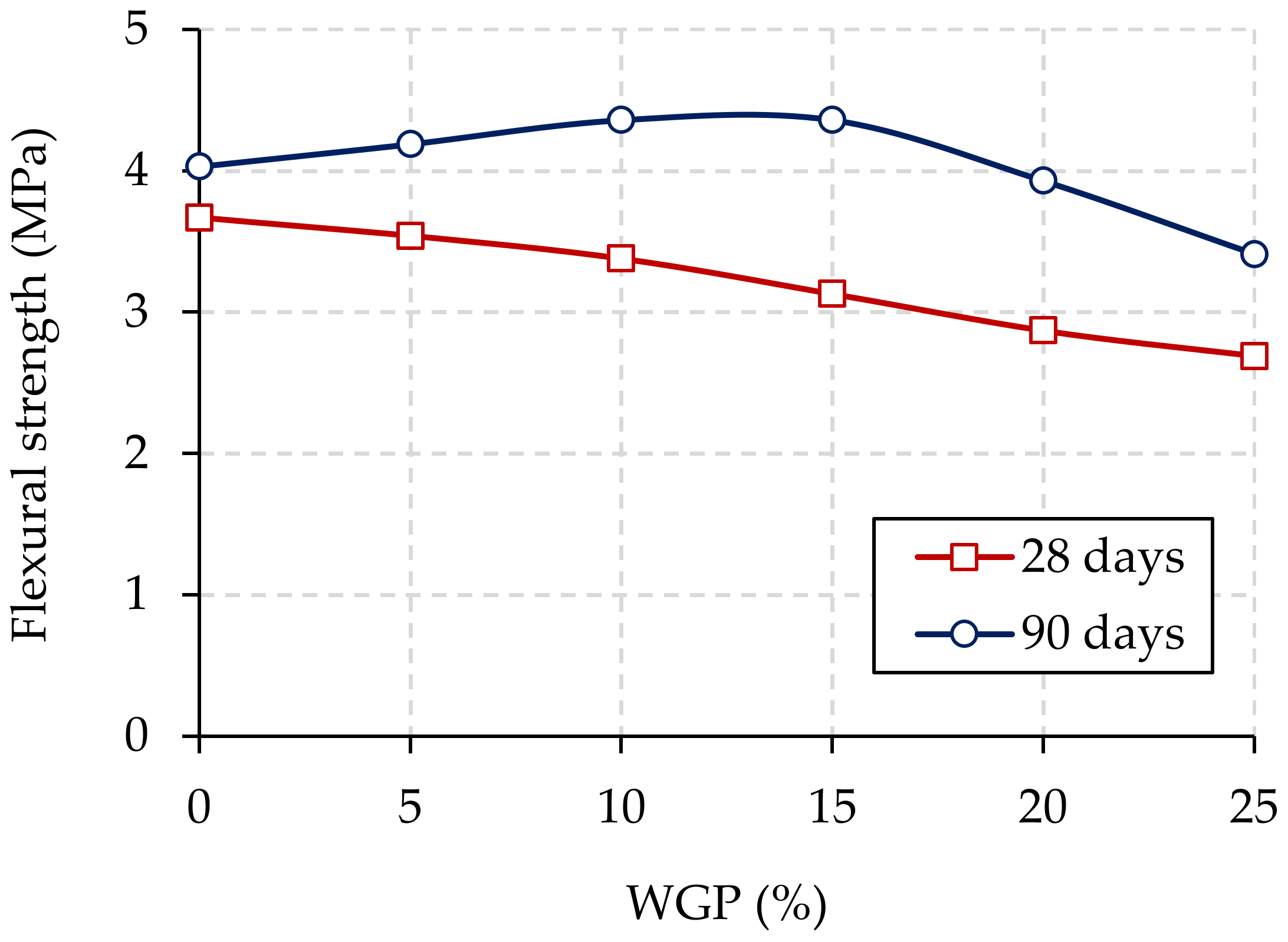

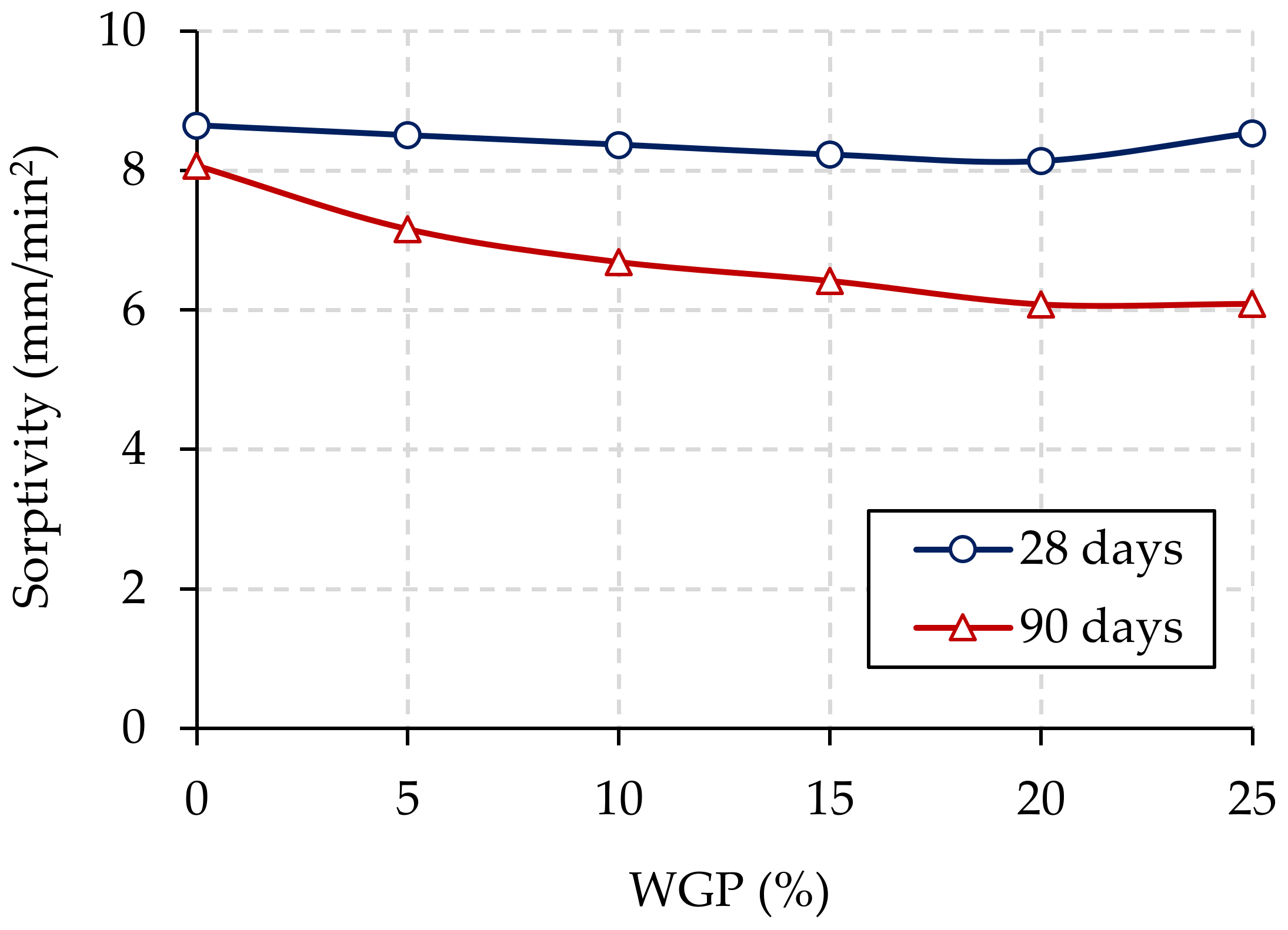
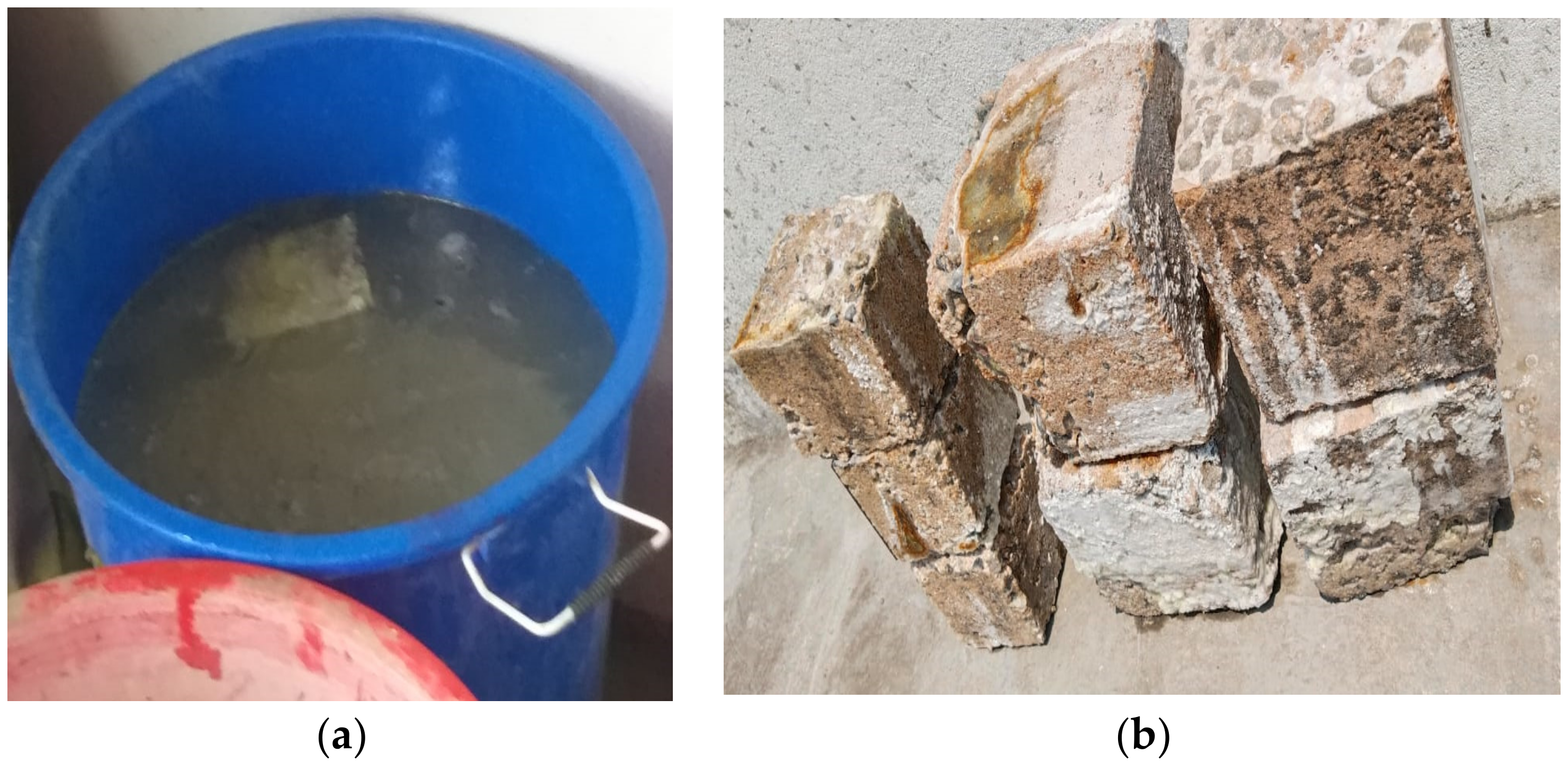
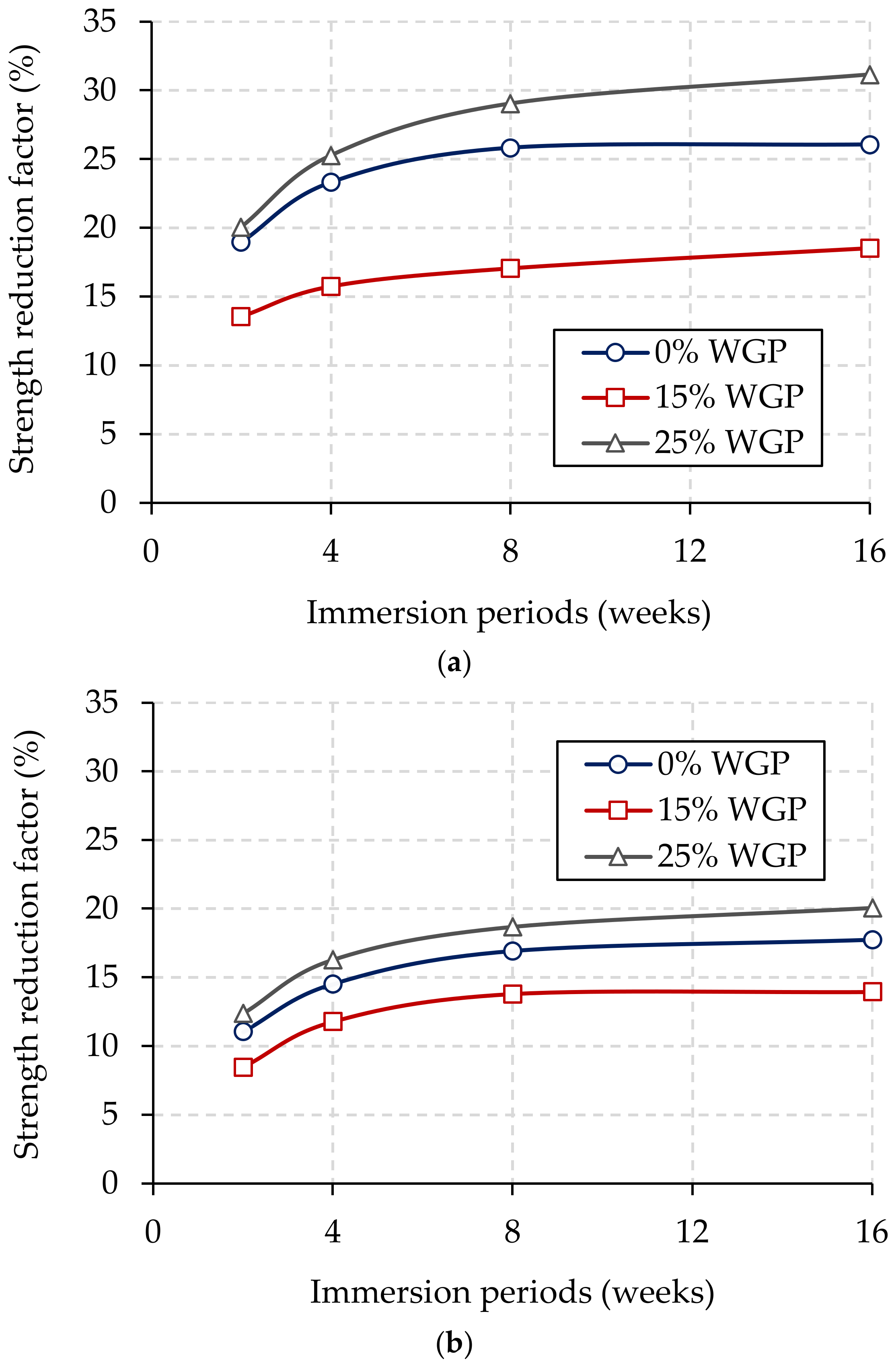


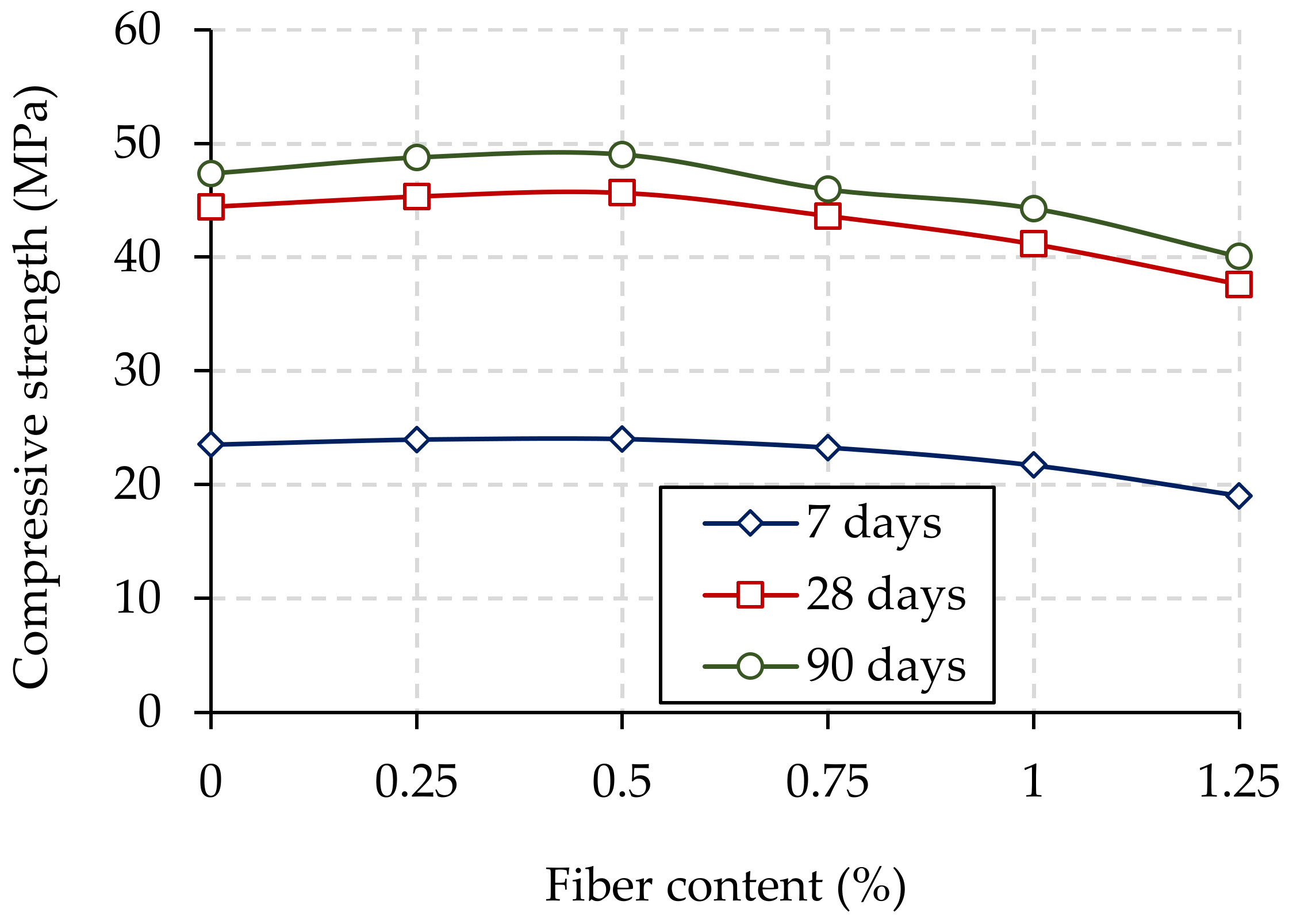
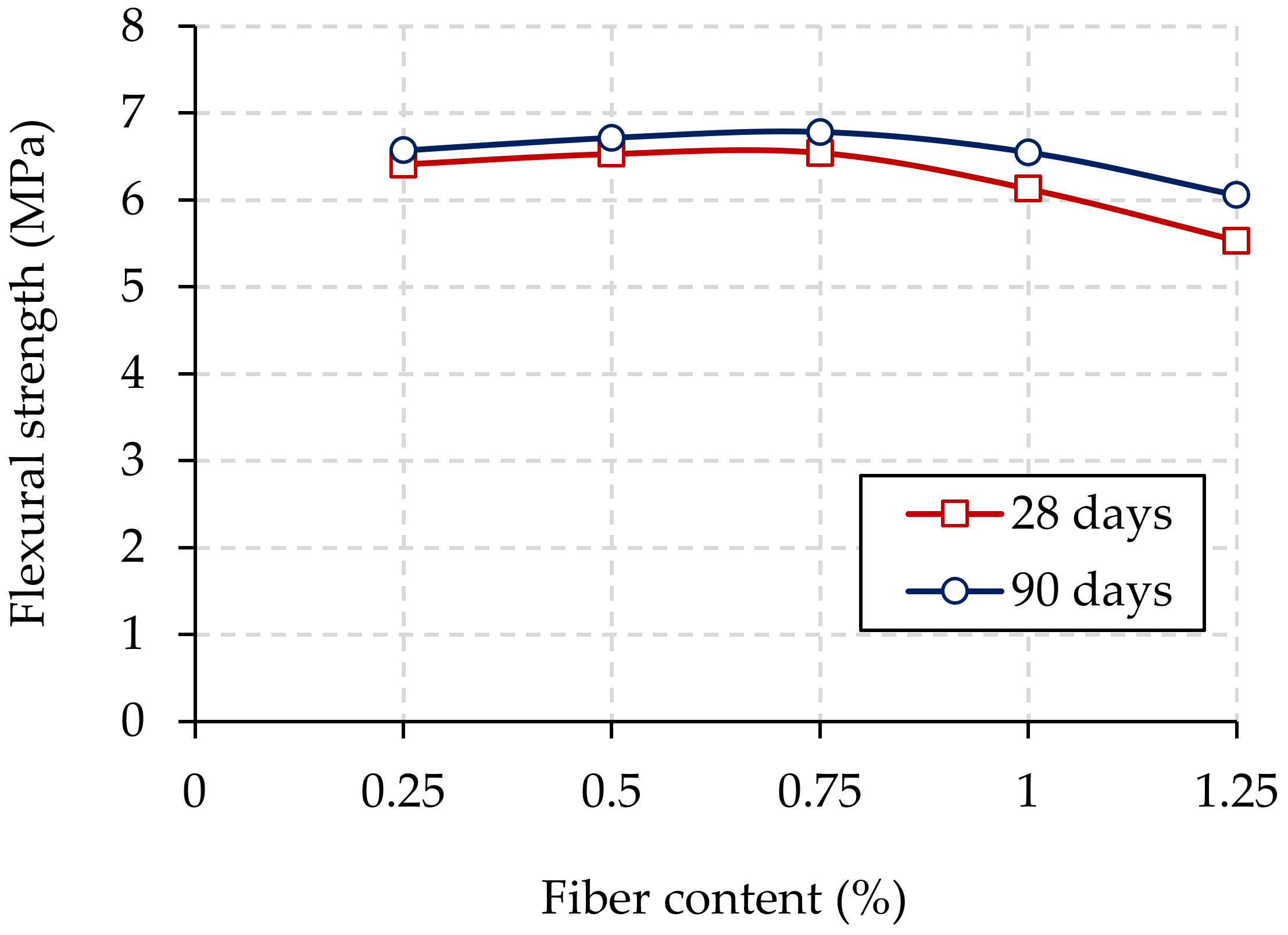
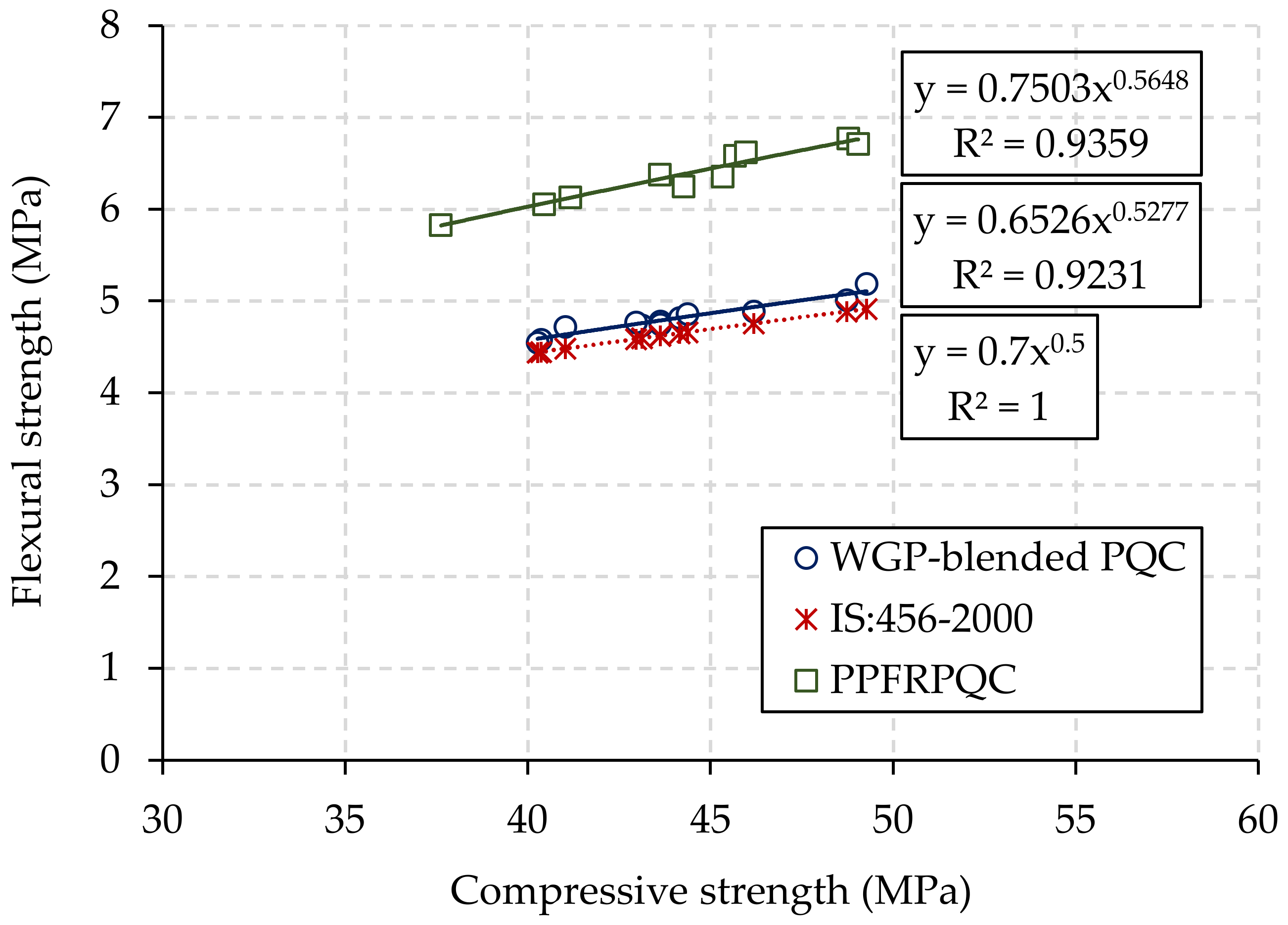

| Physical Properties | OPC | WGP |
|---|---|---|
| Specific surface area (m2/g) | 257 | 225 |
| Specific gravity | 3.15 | 2.61 |
| Chemical Compositions (%) | ||
| SiO2 | 21.92 | 72.05 |
| Al2O3 | 5.71 | 11.61 |
| Fe2O3 | 3.23 | 1.87 |
| CaO | 60.37 | 2.23 |
| MgO | 1.65 | 1.49 |
| Physical Properties | River Sand | Coarse Aggregate |
|---|---|---|
| Specific gravity | 2.63 | 2.76 |
| Grading of aggregate | Grading zone—II | Single-sized |
| Fineness modulus | 2.37 | 6.71 |
| Bulk density (kg/m3) | 1656 | 1705 |
| Water absorption (%) | 0.80 | 0.55 |
| Flakiness index (%) | - | 14.57 |
| Elongation index (%) | - | 14.63 |
| Impact value (%) | - | 11.29 |
| Crushing value (%) | - | 12.68 |
| Mix Designation | Ingredients (kg/m3) | |||||||
|---|---|---|---|---|---|---|---|---|
| OPC | WGP | Sand | CA | w/c | Water | |||
| GP0 | 100% | 400 | 0% | 0 | 710 | 1120 | 0.45 | 180 |
| GP5 | 95% | 380 | 5% | 20 | 710 | 1120 | 0.45 | 180 |
| GP10 | 90% | 360 | 10% | 40 | 710 | 1120 | 0.45 | 180 |
| GP15 | 85% | 340 | 15% | 60 | 710 | 1120 | 0.45 | 180 |
| GP20 | 80% | 320 | 20% | 80 | 710 | 1120 | 0.45 | 180 |
| GP25 | 75% | 300 | 25% | 100 | 710 | 1120 | 0.45 | 180 |
| Mix Designation | Ingredients (kg/m3) | ||||||
|---|---|---|---|---|---|---|---|
| OPC (82%) | WGP (18%) | Fiber | Sand | CA | Water | ||
| WGP18F0 | 328 | 72 | 0% | 0 | 710 | 1120 | 180 |
| WGP18F1 | 328 | 72 | 0.25% | 6.025 | 710 | 1120 | 180 |
| WGP18F2 | 328 | 72 | 0.5% | 12.05 | 710 | 1120 | 180 |
| WGP18F3 | 328 | 72 | 0.75% | 18.075 | 710 | 1120 | 180 |
| WGP18F4 | 328 | 72 | 1.0% | 24.10 | 710 | 1120 | 180 |
| WGP18F5 | 328 | 72 | 1.25% | 30.125 | 710 | 1120 | 180 |
Disclaimer/Publisher’s Note: The statements, opinions and data contained in all publications are solely those of the individual author(s) and contributor(s) and not of MDPI and/or the editor(s). MDPI and/or the editor(s) disclaim responsibility for any injury to people or property resulting from any ideas, methods, instructions or products referred to in the content. |
© 2023 by the authors. Licensee MDPI, Basel, Switzerland. This article is an open access article distributed under the terms and conditions of the Creative Commons Attribution (CC BY) license (https://creativecommons.org/licenses/by/4.0/).
Share and Cite
Murthi, P.; Lavanya, V.; Bahrami, A.; Poongodi, K. Performance Evaluation of Polypropylene Fiber-Reinforced Pavement Quality Concrete Made with Waste Granite Powder. Buildings 2023, 13, 1294. https://doi.org/10.3390/buildings13051294
Murthi P, Lavanya V, Bahrami A, Poongodi K. Performance Evaluation of Polypropylene Fiber-Reinforced Pavement Quality Concrete Made with Waste Granite Powder. Buildings. 2023; 13(5):1294. https://doi.org/10.3390/buildings13051294
Chicago/Turabian StyleMurthi, Palanisamy, Velpula Lavanya, Alireza Bahrami, and Kolandasamy Poongodi. 2023. "Performance Evaluation of Polypropylene Fiber-Reinforced Pavement Quality Concrete Made with Waste Granite Powder" Buildings 13, no. 5: 1294. https://doi.org/10.3390/buildings13051294






